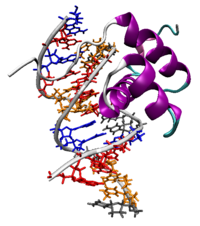
Photo from wikipedia
With the fast growth of protein therapeutics, efficient, precise, and universal delivery platforms are highly required. However, very few reports have discussed the progress of precisely spatiotemporal-controlled protein delivery. Therefore,… Click to show full abstract
With the fast growth of protein therapeutics, efficient, precise, and universal delivery platforms are highly required. However, very few reports have discussed the progress of precisely spatiotemporal-controlled protein delivery. Therefore, a mini library of well-designed amino acid-based poly(ester amide)s derived from lysine (Lys-aaPEAs) has been developed. Lys-aaPEAs can interact with and encapsulate proteins into nanocomplexes via electrostatic interactions. The chemical structure of Lys-aaPEAs can be finely tuned by changing the type and molar ratio of the monomers. Studies of structure-function relationships reveal that the carbon chain length of diacid/diol segments, hydrophilicity, and electrical properties affect the polymer-protein interaction, cell-material interaction, and, therefore, the outcome of protein delivery. By modulating the structures of Lys-aaPEAs, the delivery systems could present customized physiochemical and biological properties and perform time- and space-specific protein release and delivery without causing any systematic toxicity. The screened systems exhibited prolonged hypoglycemic activity and superior biosafety in vivo, using insulin as a model protein and a mouse model bearing type 1 diabetes mellitus (T1DM). This work establishes a novel lysine-based polymer platform for spatiotemporal-controlled protein delivery and offers a paradigm of precise structure-function controllability for designing the next generation of polymers.
Journal Title: ACS applied materials & interfaces
Year Published: 2022
Link to full text (if available)
Share on Social Media: Sign Up to like & get
recommendations!